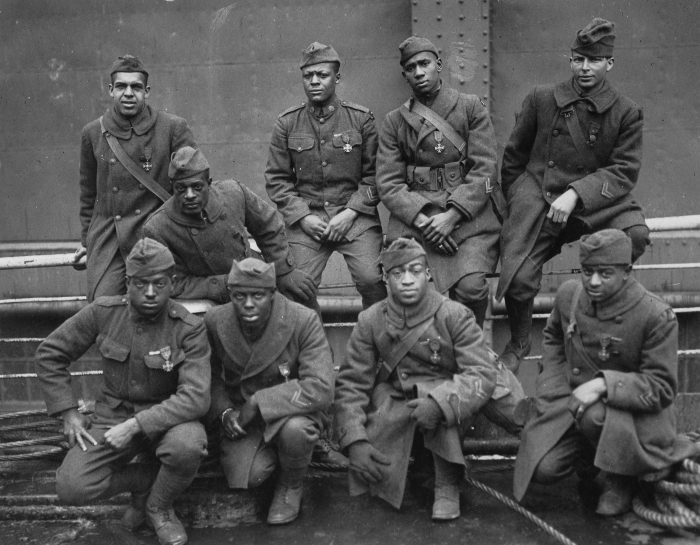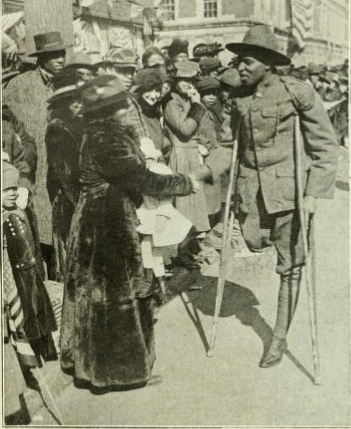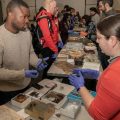Monuments and Memory: Honoring Veterans at the Smithsonian
Secretary Bunch reflects on the personal impact of war on its veterans.
My father served in Germany in World War II, and he always made sure that we paid attention to Veterans’ Day. Every year, he’d take me into town to see the local parade. I was captivated by it. Not by the tanks and spectacle of the event, but by the people. As a kid growing up in the wake of the war, it was the limps that stuck out to me, and the growing sense that these people had sacrificed something for the country. Honoring them was not only about valor and victory; it meant recognizing that they carried a burden for our freedom.
To me, the strength of Veterans’ Day is that it reminds us of how human and how personal the stakes of war are. It invites us to remember our history, honoring both those who recently served and those whose service was long ago. And it asks us to recognize those whose stories and services to our country have remained overlooked for too long.
With our collections, expertise, and national presence, the Smithsonian has a unique opportunity to honor these values. That’s why I am so excited by the National Native American Veterans Memorial at the National Museum of the American Indian (NMAI). Since the American Revolution, native people have served in the United States military and continue to do at one of the highest rates per capita of any population group. When the memorial is unveiled at its dedication ceremony next November, it will carry a deep responsibility – acknowledging and celebrating the long history of American Indian, Alaska Native, and Native Hawaiian veterans in the military. As commissioned by Congress, the memorial will recognize – for the first time on a national scale – the extraordinary service of these men and women and our shared obligation to honor this legacy.

Eagle-feather war bonnets adorn U.S. military uniform jackets at a Ton-Kon-Gah (Black Leggings Society) ceremonial, held annually to honor Kiowa tribal veterans. Near Anadarko, Oklahoma, 2006. (National Museum of the American Indian)
I am struck by the words of NMAI director Kevin Gover in his announcement of the selected design for the memorial: “Through meeting with thousands of American Indian veterans, I have learned most of all about the commitment these men and women have to the well-being of the United States. They are perfectly aware that they are serving a country that had not kept its commitments to Indians and yet they chose – and are still choosing – to serve,” Gover wrote. “I can think of no finer example of service to the United States and the promise it holds.”
Throughout our history, the values of the United States have been upheld abroad by the strength of individuals whose rights this country has failed to protect at home. I think, for instance, of the upcoming exhibition We Return Fighting: The African American Experience in World War I, opening next month at the National Museum of African American History and Culture. For many Americans today, the sacrifices that African Americans made in World War I, and the ways that the war transformed those soldiers and their communities seem remote: 100 years removed, fought on shores far from our own. The exhibition will help us look not only at the forgotten war, but the forgotten community of soldiers who participated, what they faced when they returned home, and the ways that this community shaped the country.
More than 200,000 African American soldiers served in segregated units of the American Expeditionary Force on the war’s Western Front. Even in service, black Americans faced oppressive conditions, and found themselves relegated to labor and support duties. Black soldiers in Europe, especially those serving under the French army, were often afforded the equipment, training, medical attention, and recognition that those under American command did not receive. The French even awarded the Croix de Guerre, France’s highest military honor, to members of the Harlem Hellfighters, the 369th Infantry Regiment that spent more time in the frontline trenches than any other American unit. The United States awarded few medals to any black soldiers, and in many cases not until decades later.

“Some of the colored men of the 369th (15th N.Y.) who won the Croix de Guerre for gallantry in action.” Left to right. Front row: Pvt. Ed Williams, Herbert Taylor, Pvt. Leon Fraitor, Pvt. Ralph Hawkins. Back Row: Sgt. H. D. Prinas, Sgt. Dan Strorms, Pvt. Joe Williams, Pvt. Alfred Hanley, and Cpl. T. W. Taylor. 1998 print of 1919 photograph. Records of the War Department General and Special. Staffs. (165-WW-127-8)
Date 1919
The country to which black veterans returned after 1918 showed little gratitude for their service. Anti-black riots proliferated across the country throughout the summer of 1919; lynchings rose steeply, and victims included black veterans. The US military would not be desegregated until 1948, after the next World War.
Still, many of those African American soldiers who had fought for democracy abroad returned with a strengthened commitment to fight for democracy at home and win the rights of full citizenship. Echoes of that commitment resounded across the Civil Rights movement of the 20th century.
When I was very young, my grandfather used to read to me before bedtime. I always loved a history book by Emmett Scott called The American Negro in the World War. There was one photograph in it that entranced me. An African American soldier recently returned from the European front, marching in a victory parade along New York’s Fifth Avenue in the winter of 1919. He walks with crutches, his right leg missing from the thigh down.

A returning hero of the 369th who lost his leg in France, being welcomed on his return home to New York. The loop of cord on his left shoulder is the decoration that every member of this regiment is entitled to wear. It signifies that the entire regiment has been awarded the Cordon of the Croix de Guerre by the French.
From “Scott’s Official History of the American Negro in the World War” by Emmett J. Scott, 1873-1957.
Publication date 1919. Chicago : Homewood Press; Digitizing sponsor and Internet Archive Contributor University of California Libraries
This image sticks with me. It’s one of the reasons that I became so fascinated by history in the first place. It is an indelible reminder of the service and sacrifice of generations of Americans. It is a reminder of our duty to honor those individuals and their legacy, especially those that history has been quick to forget. It is a reminder that the struggle for and success of full democratic rights – both at home and abroad – depend on how and what we choose to memorialize.
Posted: 14 November 2019
- Categories:







Good day Secretary Bunch,
Such a fantastic story of the trials and tribulations of African Americans many of whom who served as Soldiers. Their contributions and sacrifice can never be fully recognized and appreciated from the society in which we live.
My father served in both WWll and the Vietnam War. I always respected his service and even served myself.
Thank you for your fathers service and all those whom gave so much to a country who never fails to serve those who deserve the best our country has to offer.
Peace and Blessings.